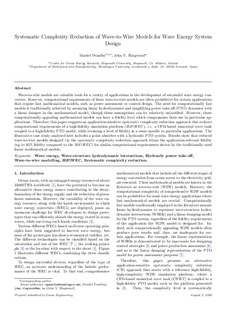
Título
Systematic complexity reduction of wave-to-wire models for wave energy system designAutor-a
Autor-a (de otra institución)
Fecha de publicación
2020Otras instituciones
National University of Ireland, MaynoothVersión
PostprintTipo de documento
ArtículoArtículoIdioma
InglésDerechos
© 2020 Elsevier Ltd.Acceso
Acceso embargadoFin de la fecha de embargo
2022-12-31Versión de la editorial
https://doi.org/10.1016/j.oceaneng.2020.107651Publicado en
Ocean Engineering Vol. 217. N. Art. 107651, 2020Editorial
Elsevier Ltd.Palabras clave
Wave energy
Wave-structure hydrodynamic interactions
Hydraulic power take-off
Wave-to-wire modelling ... [+]
Wave-structure hydrodynamic interactions
Hydraulic power take-off
Wave-to-wire modelling ... [+]
Wave energy
Wave-structure hydrodynamic interactions
Hydraulic power take-off
Wave-to-wire modelling
HiFiWEC
Systematic complexity reduction [-]
Wave-structure hydrodynamic interactions
Hydraulic power take-off
Wave-to-wire modelling
HiFiWEC
Systematic complexity reduction [-]
Resumen
Wave-to-wire models are valuable tools for a variety of applications in the development of successful wave energy converters. However, computational requirements of these wave-to-wire models are often ... [+]
Wave-to-wire models are valuable tools for a variety of applications in the development of successful wave energy converters. However, computational requirements of these wave-to-wire models are often prohibitive for certain applications that require fast mathematical models, such as power assessment or control design. The need for computationally fast models is traditionally achieved by assuming linear hydrodynamics and simplifying power take-off (PTO) dynamics with a linear damper in the mathematical model, though these assumptions can be relatively unjustified. However, these computationally appealing mathematical models can have a fidelity level which compromises their use in particular applications. Therefore, this paper suggests an application- sensitive systematic complexity reduction approach that reduces computational requirements of a high-fidelity simulation platform (HiFiWEC), i.e. a CFD-based numerical wave tank coupled to a high-fidelity PTO model, while retaining a level of fidelity in a sense specific to particular applications. The illustrative case study analysed here includes a point absorber with a hydraulic PTO system. Results show that reduced wave-to-wire models designed via the systematic complexity reduction approach retain the application-relevant fidelity (up to 95% fidelity compared to the HiFiWEC) for similar computational requirements shown by the traditionally used linear mathematical models. [-]
Sponsorship
Science Foundation IrelandColecciones
- Artículos - Ingeniería [762]




















